engine overheat Oldsmobile Achieva 1998 s User Guide
[x] Cancel search | Manufacturer: OLDSMOBILE, Model Year: 1998, Model line: Achieva, Model: Oldsmobile Achieva 1998Pages: 356, PDF Size: 18.04 MB
Page 204 of 356

If No Steam Is Coming From Your Engine
If you get the overheat warning but see or hear no
steam, the problem may not be too serious. Sometimes
the engine can get a little too hot when you:
Climb a long hill on a hot day.
Stop after high-speed driving.
Idle for long periods in traffic.
Tow a trailer.
If you get the overheat warning with no sign of steam,
try this for a minute or
so:
1. Turn off your air conditioner.
2. Turn on your heater to full hot at the highest fan
speed and open the window as necessary.
3. If you’re in a traffic jam, shift to NEUTRAL (N);
otherwise, shift to the highest gear while
driving
-- AUTOMATIC OVERDRIVE (@)
or DRIVE (D).
If you no longer have the overheat warning, you can
drive. Just to be safe, drive slower for about
10 minutes.
If the warning doesn’t come back on, you can
drive normally.
If the warning continues, pull over,
stop, and park your
vehicle right away.
If there’s still no sign of steam, you can idle the engine
for two or three minutes while you’re parked, to see if
the warning stops. But then, if you still have the
warning, turn oathe engine
and get everyone out of the
vehicle until it cools down.
You may decide not to lift the hood but to get service
help right away.
5-16
Page 207 of 356
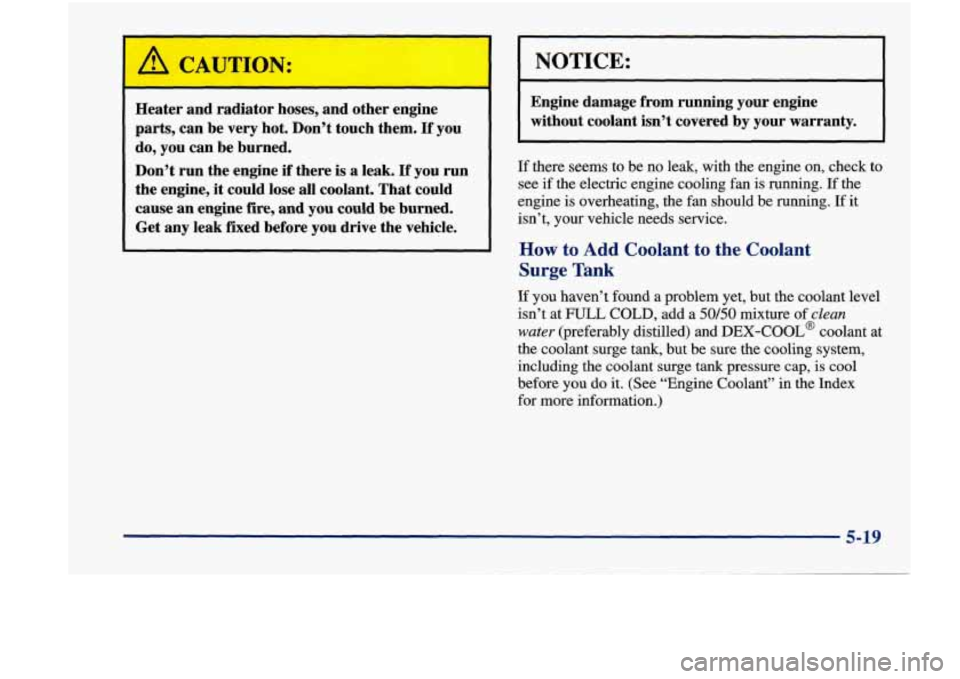
, ,- CAUTION:
~ Heater and radiator hoses, and other engine
1 parts, can be very hot. Don’t touch them. If you
l do, you can be burned.
Don’t run the engine
if there is a leak. If you run
1 the engine, it could lose all coolant. That could
cause an engine
fire, and you could be burned.
’ Get any leak fixed before you drive the vehicle.
NOTICE:
Engine damage from running your engine
without coolant isn’t covered by your warranty.
.
If there seems to be no leak, with the engine on, check to
see if the electric engine cooling fan is running.
If the
engine is overheating, the fan should be running.
If it
isn’t, your vehicle needs service.
How to Add Coolant to the Coolant
Surge Tank
If you haven’t found a problem yet, but the coolant level
isn’t at
FULL COLD, add a 50/50 mixture of clean
water (preferably distilled) and DEX-COOL@ coolant at
the coolant surge tank, but be sure the cooling system,
including the coolant surge
tank pressure cap, is cool
before you do it. (See “Engine Coolant” in the Index
for more information.)
5-19
Page 209 of 356
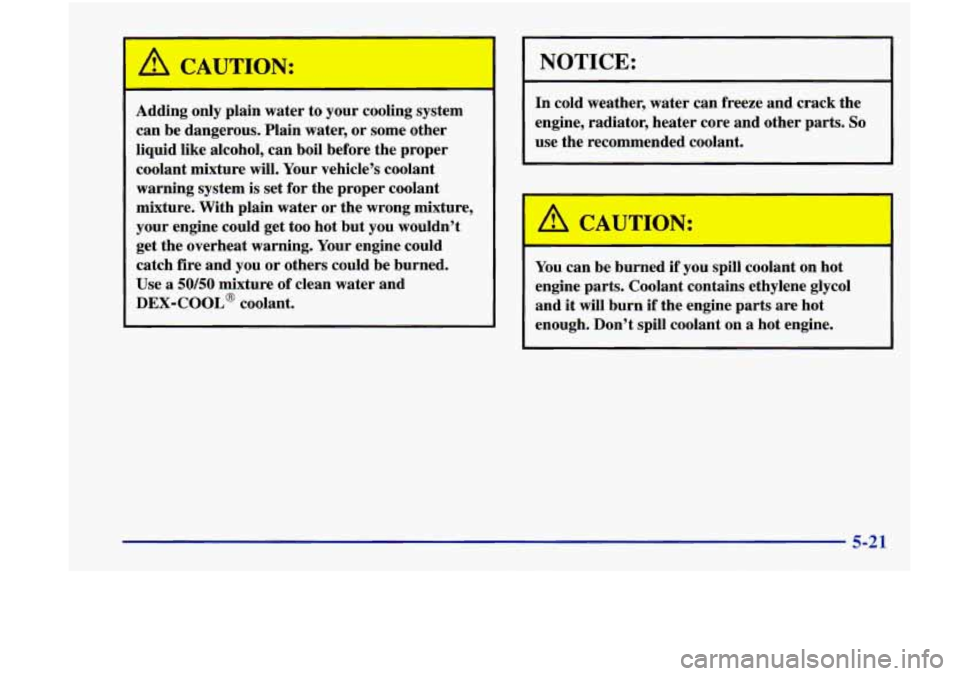
A CAUTION:
Adding only plain water to your cooling system
can be dangerous. Plain
water, or some other
liquid like alcohol, can boil before the proper
coolant mixture will. Your vehicle’s coolant
warning system is set for the proper coolant
mixture. With plain water or the wrong mixture,
your engine could get too hot but you wouldn’t
get the overheat warning. Your engine could
catch fire and you or others could be burned.
Use
a 50/50 mixture of clean water and
DEX-COOL@ coolant.
I NOTICE:
In cold weather, water can freeze and crack the
engine, radiator, heater core and other parts.
So
use the recommended coolant.
A CAUTION:
~
You can be burned if you spill coolant on hot
engine parts. Coolant contains ethylene glycol
and it will burn
if the engine parts are hot
enough. Don’t spill coolant on a hot engine.
5-21
Page 225 of 356

If You’re Stuck: In Sand, Mud,
Ice
or Snow
What you don’t want to do when your vehicle is stuck is
to spin your wheels too fast. The method known as
“rocking” can help you get out when you’re stuck, but
you must use caution.
IN:
If you let your tires spin at high speed, they can
explode, and you or others could be injured. And,
the transaxle or other parts of the vehicle can
overheat. That could cause an engine
compartment fire or other damage. When you’re
stuck, spin the wheels
as little as possible. Don’t
spin the wheels above
35 mph (55 kmh) as shown
on the speedometer.
I NOTICE:
Spinning your wheels can destroy parts of your
vehicle
as well as the tires. If you spin the wheels
too fast while shifting your transaxle back and
forth, you can destroy your transaxle.
For information about using tire chains on your vehicle,
see “Tire Chains” in the Index.
Rocking Your Vehicle To Get It Out
First, turn your steering wheel left and right. That will
clear the area around your front wheels.
If your vehicle has
the Enhanced Traction System, you should
turn the system
off. (See “Enhanced Traction System” in the Index.) Then
shift back and
forth between REVERSE (R) and a forward
gear, spinning the wheels as little as
possible. Release the
accelerator pedal while you
shift, and press lightly on the
accelerator pedal when the transaxle is in gear.
If that
doesn’t get you out after a few tries, you may need to be
towed out. If you do need to be towed out, see “Towing
Your Vehicle”
in the Index.
5-37
Page 249 of 356
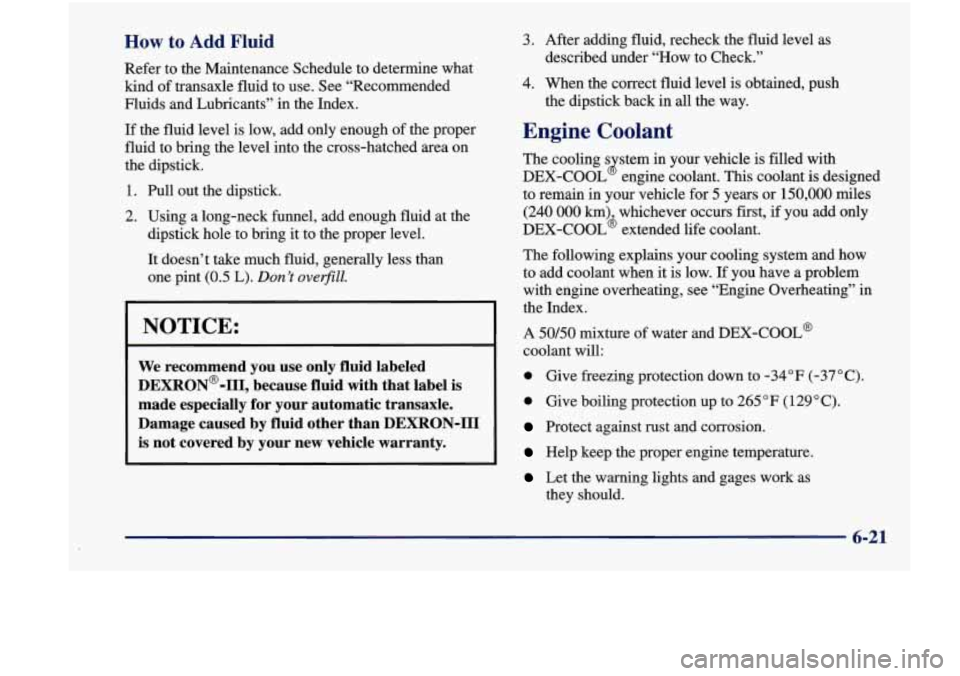
How to Add Fluid
Refer to the Maintenance Schedule to determine what
kind of transaxle fluid to use. See “Recommended
Fluids and Lubricants” in the Index.
If the fluid level is low, add only enough of the proper
fluid to bring the level into the cross-hatched area on
the dipstick.
1. Pull out the dipstick.
2. Using a long-neck hnnel, add enough fluid at the
dipstick hole to bring
it to the proper level.
3. After adding fluid, recheck the fluid level as
described under “How to Check.”
4. When the correct fluid level is obtained, push
the dipstick back in all the way.
Engine Coolant
The cooling s stem in your vehicle is filled with
DEX-COOL engine coolant.
This coolant is designed
to remain in your vehicle for 5 years or
150,000 miles
(240 000 km) whichever occurs first, if you add only
DEX-COOL’ extended life coolant.
B
It doesn’t take much fluid, generally less than The following explains your cooling system and how
one pint
(0.5 L). Don’t oveflZZ. to add coolant when it is low. If you have a problem
with engine overheating, see “Engine Overheating” in
I 3 the Index.
NOTICE: A 50/50 mixture of water and DEX-COOL@
coolant will:
We recommend you use only fluid labeled
DEXRON@-III, because fluid with that label is
made especially for your automatic transaxle.
is not covered by your new vehicle warranty.
Protect against rust and corrosion. Damage caused by fluid other than DEXRON-III
a Give boiling protection up to 265 “F (129 “C).
a Give freezing protection down to -34°F (-37°C).
Help keep the proper engine temperature. z
Let the warning lights and gages work as
they should.
6-21
Page 250 of 356
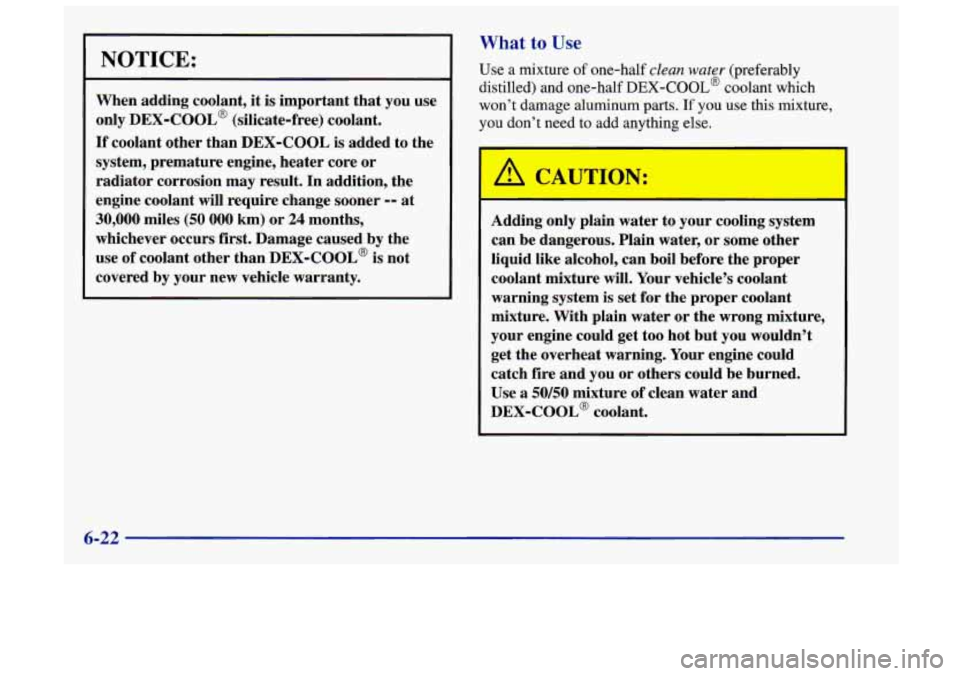
NOTICE:
When adding coolant, it is important that you use
only
DEX-COOL’ (silicate-free) coolant.
If coolant other than DEX-COOL is added to the
system, premature engine, heater core or
radiator corrosion may result. In addition, the
engine coolant will require change sooner
-- at
30,000 miles (50 000 km) or 24 months,
whichever occurs
first. Damage caused by the
use of coolant other than DEX-COOL’
is not
covered by your new vehicle warranty.
What to Use
Use a mixture of one-half clean water (preferably
distilled) and one-half
DEX-COOL@ coolant which
won’t damage aluminum parts.
If you use this mixture,
you don’t need to add anything else.
Adding only plain water to your cooling system
can be dangerous. Plain water, or some other
liquid like alcohol, can boil before the proper
coolant mixture will. Your vehicle’s coolant
warning system is set for the proper coolant
mixture, With plain water or the wrong mixture,
your engine could get too hot but you wouldn’t
get the overheat warning. Your engine could
catch fire and you or others could be burned.
Use a
50/50 mixture of clean water and
DEX-COOL@ coolant,
6-22
Page 251 of 356
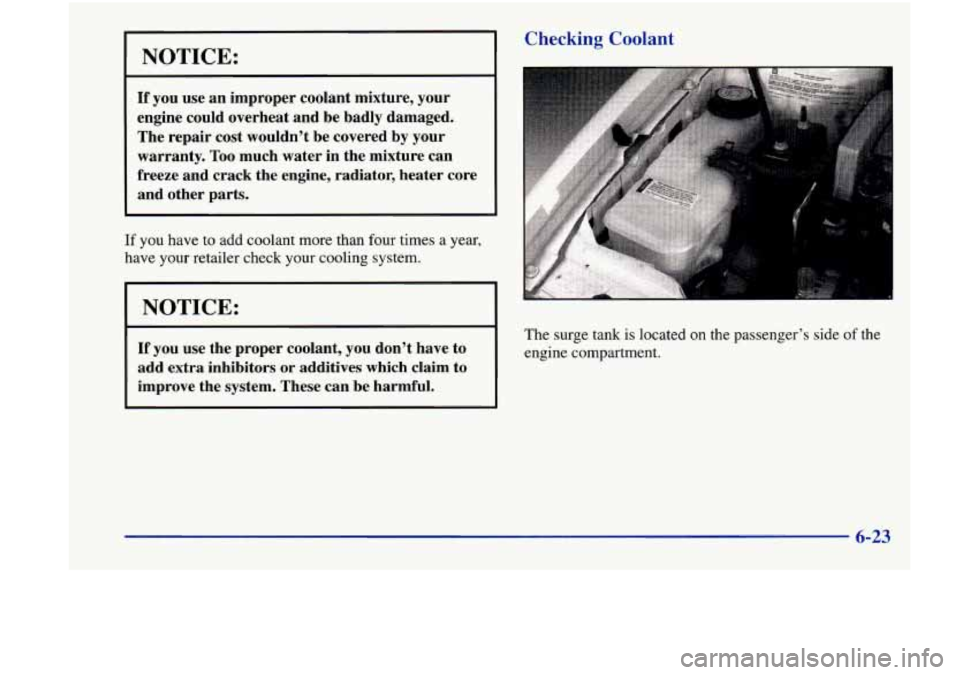
NOTICE:
If you use an improper coolant mixture, your
engine could overheat and be badly damaged.
The repair cost wouldn’t be covered by your
warranty. Too much water in the mixture can
freeze and crack the engine, radiator, heater core
and other parts.
If you have to add coolant more than four times a year,
have your retailer check your cooling system.
I NOTICE: I
If you use the proper coolant, you don’t have to
add extra inhibitors or additives which claim to
improve the system. These can be harmful.
Checking Coolant
The surge tank is located on the passenger’s side of the
engine compartment.
6-23
Page 253 of 356
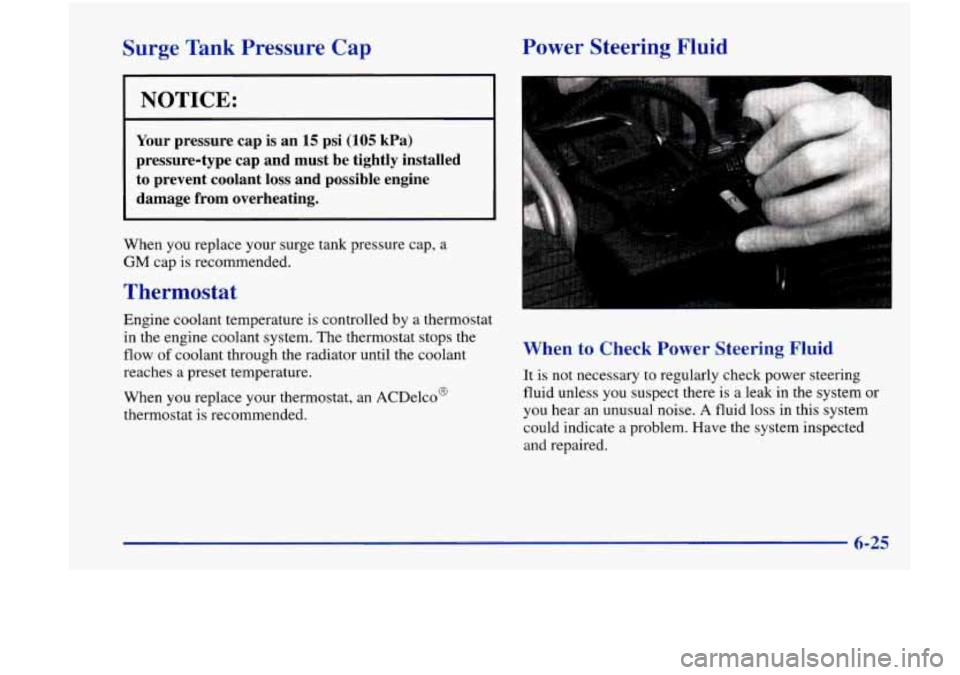
Surge Tank Pressure Cap Power Steering Fluid
I NOTICE:
Your
pressure cap is an 15 psi (105 kPa)
pressure-type cap and must
be tightly installed
to prevent coolant loss and possible engine
damage from overheating.
When you replace your surge tank pressure cap, a
GM cap is recommended.
Thermostat
Engine coolant temperature is controlled by a thermostat
in the engine coolant system. The thermostat stops the
flow
of coolant through the radiator until the coolant
reaches a preset temperature.
When you replace your thermostat, an ACDelco@
thermostat is recommended. When to Check Power Steering Fluid
It is not necessary to regularly check power steering
fluid unless you suspect there
is a leak in the system or
you hear an unusual noise. A fluid loss in this system
could indicate
a problem. Have the system inspected
and repaired.
Page 281 of 356
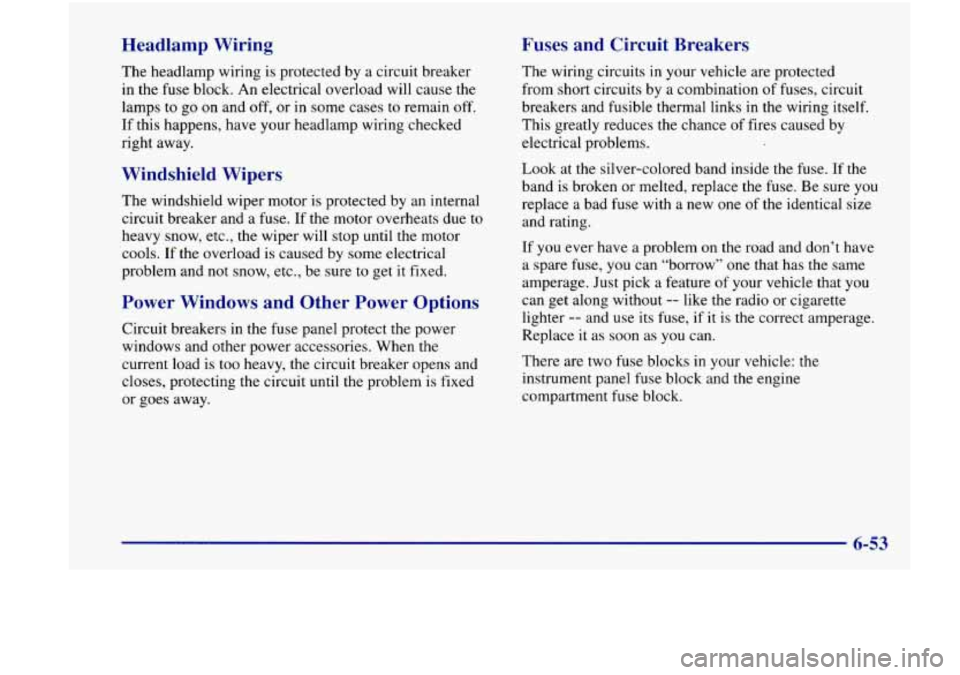
Headlamp Wiring Fuses and Circuit Breakers
The
headlamp wiring is protected by a circuit breaker
in the fuse block. An electrical overload will cause the
lamps to go on and off, or in some cases to remain off.
If this happens, have your headlamp wiring checked
right away.
Windshield Wipers
The windshield wiper motor is protected by an internal
circuit breaker and a
fuse. If the motor overheats due to
heavy snow, etc., the wiper will stop until the motor
cools.
If the overload is caused by some electrical
problem and not snow, etc., be sure to get it fixed.
Power Windows and Other Power Options
Circuit breakers in the fuse panel protect the power
windows and other power accessories. When the
current load is too heavy, the circuit breaker opens and
closes, protecting the circuit until the problem is fixed
or goes away. The
wiring circuits in your vehicle are protected
from short circuits by a combination of fuses, circuit
breakers and fusible thermal links in the wiring itself.
This greatly reduces the chance
of fires caused by
electrical problems.
Look at the silver-colored band inside the fuse. If the
band is broken
or melted, replace the fuse. Be sure you
replace a bad fuse with a new one
of the identical size
and rating.
If you ever have a problem on the road and don’t have
a spare fuse,
you can “borrow” one that has the same
amperage. Just pick a feature of your vehicle that
you
can get along without -- like the radio or cigarette
lighter
-- and use its fuse, if it is the correct amperage.
Replace it as soon as you can.
There are two fuse blocks in your vehicle: the
instrument panel fuse block and the engine
compartment fuse block.
Page 346 of 356
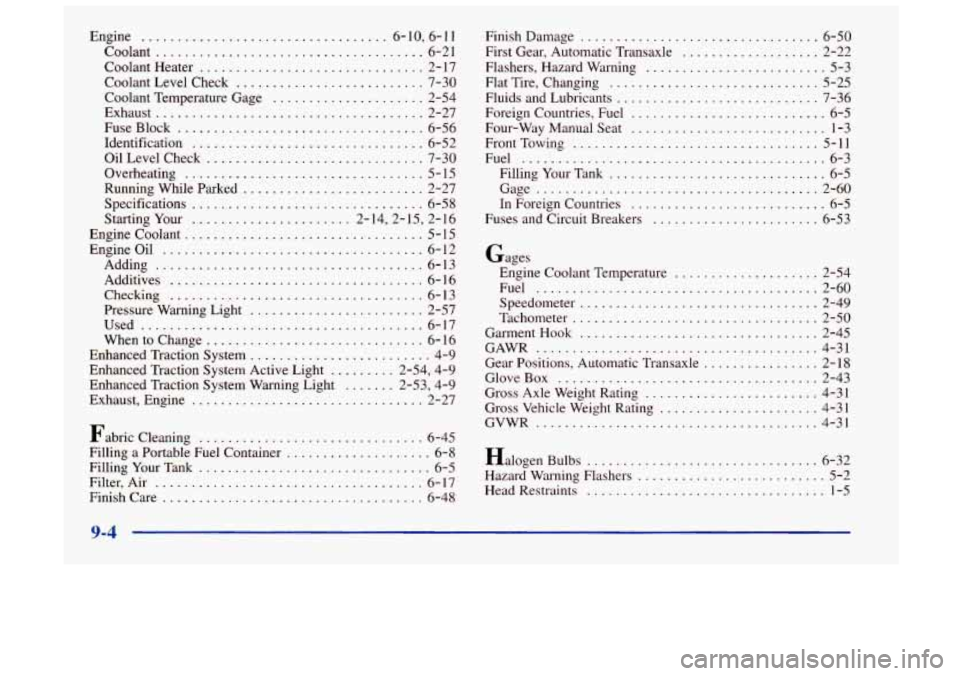
Engine .................................. 6.10. 6.11
Coolant
..................................... 6-21
Coolant Heater
............................... 2- 17
Coolant Level Check
.......................... 7-30
Coolant Temperature Gage
..................... 2-54
Exhaust
..................................... 2-27
FuseBlock
.................................. 6-56
Identification
................................ 6-52
OilLevelCheck
.............................. 7-30
Overheating
................................. 5-15
Running While Parked
......................... 2-27
Specifications
................................ 6-58
Starting Your
...................... 2.14.2.15. 2.16
Engine Coolant
................................. 5 . 15
Engineoil
.................................... 6-12
Adding
..................................... 6-13
Additives
................................... 6-16
Pressure Warning Light
........................ 2-57
Used
....................................... 6-17
Whentochange
.............................. 6-16
Enhanced Traction System
......................... 4-9
Enhanced Traction System Active Light
......... 2-54, 4-9
Enhanced Traction System Warning Light
....... 2-53, 4-9
Exhaust, Engine
................................ 2-27
Checking
................................... 6-13
Fabric Cleaning
............................... 6-45
Filling a Portable Fuel Container
.................... 6-8
FillingYourTank
................................ 6-5
Filter. Air
..................................... 6-17
Finish Care
.................................... 6-48 Finish Damage
................................. 6-50
First Gear. Automatic Transaxle
................... 2-22
Flashers. Hazard Warning
......................... 5-3
Flat Tire. Changing
............................. 5-25
Fluids and Lubricants
............................ 7-36
Foreign Countries. Fuel
........................... 6-5
Four-Way Manual Seat
........................... 1-3
Fuel
.......................................... 6-3
Filling Your Tank
.............................. 6-5
In Foreign Countries
........................... 6-5
Fuses and Circuit Breakers
....................... 6-53
FrontTowing
.................................. 5-11
Gage
....................................... 2-60
Gages Engine Coolant Temperature
.................... 2-54
Fuel
....................................... 2-60
Speedometer
................................. 2-49
Tachometer
.................................. 2-50
GarmentHook
................................. 2-45
GAWR
....................................... 4-31
Gear Positions. Automatic Transaxle
................ 2-18
GloveBox
.................................... 2-43
Gross Axle Weight Rating
........................ 4-31
Gross Vehicle Weight Rating
...................... 4-31
GVWR
....................................... 4-31
Halogen Bulbs
................................ 6-32
Hazard Warning Flashers
.......................... 5-2
Head Restraints
................................. 1-5
9-4